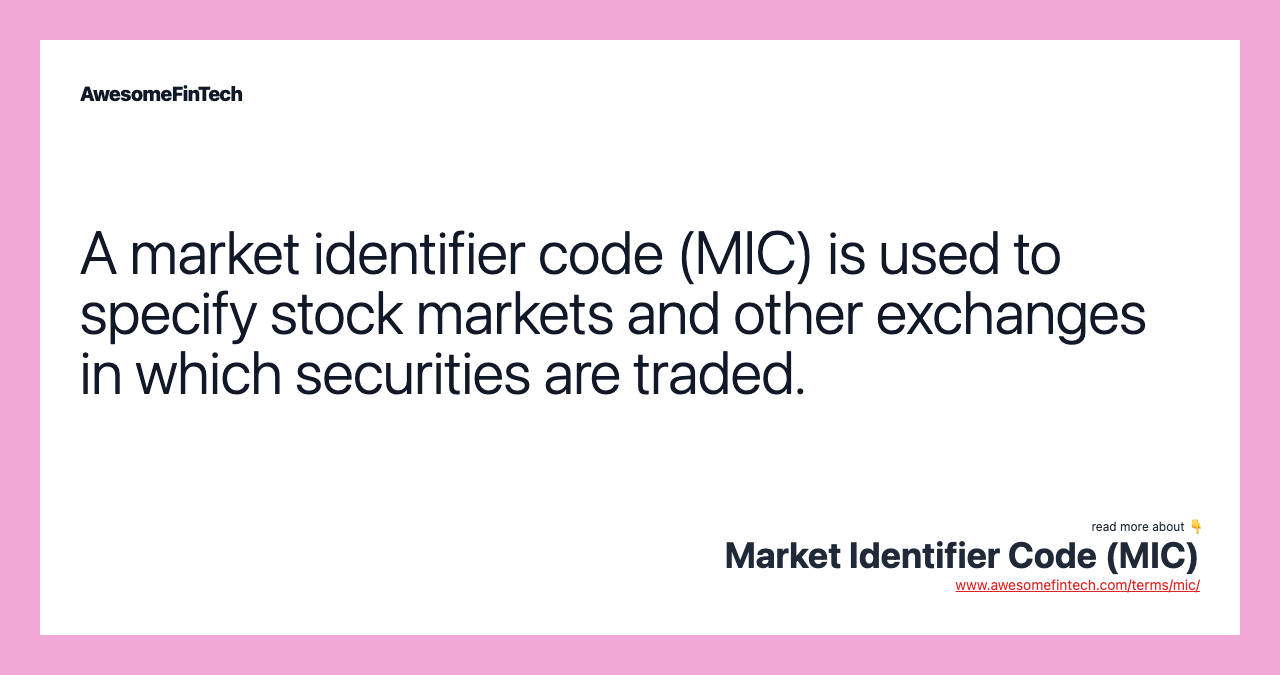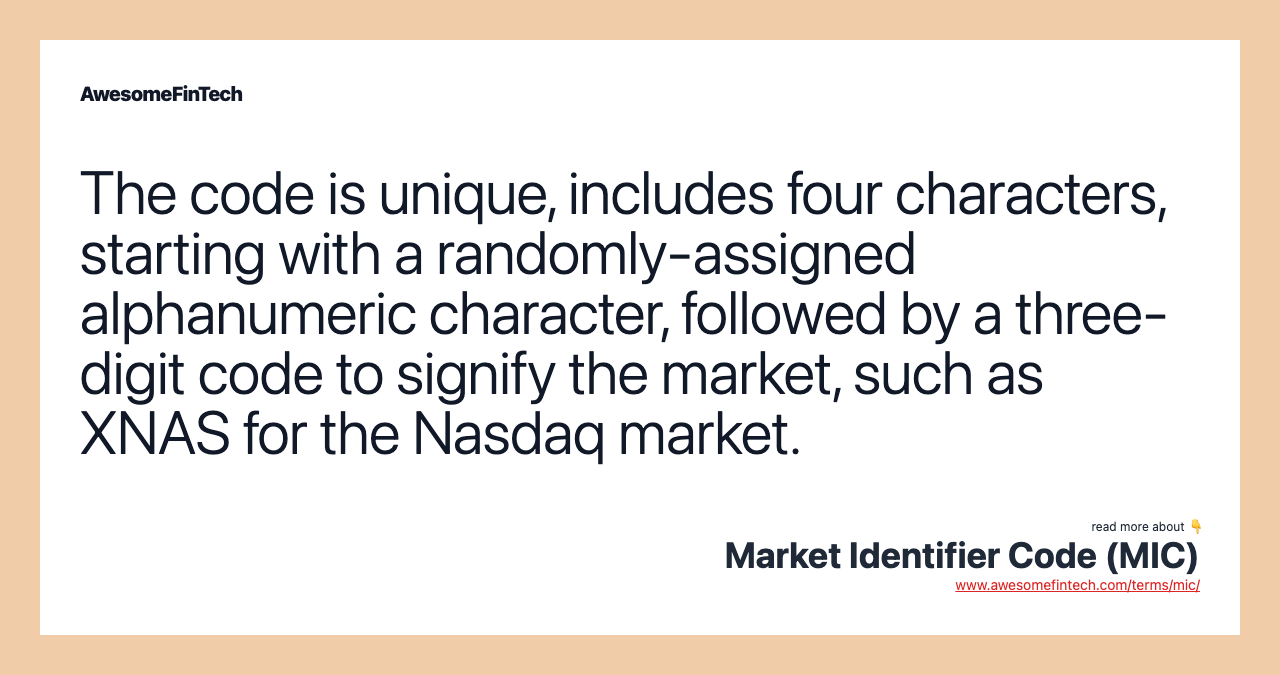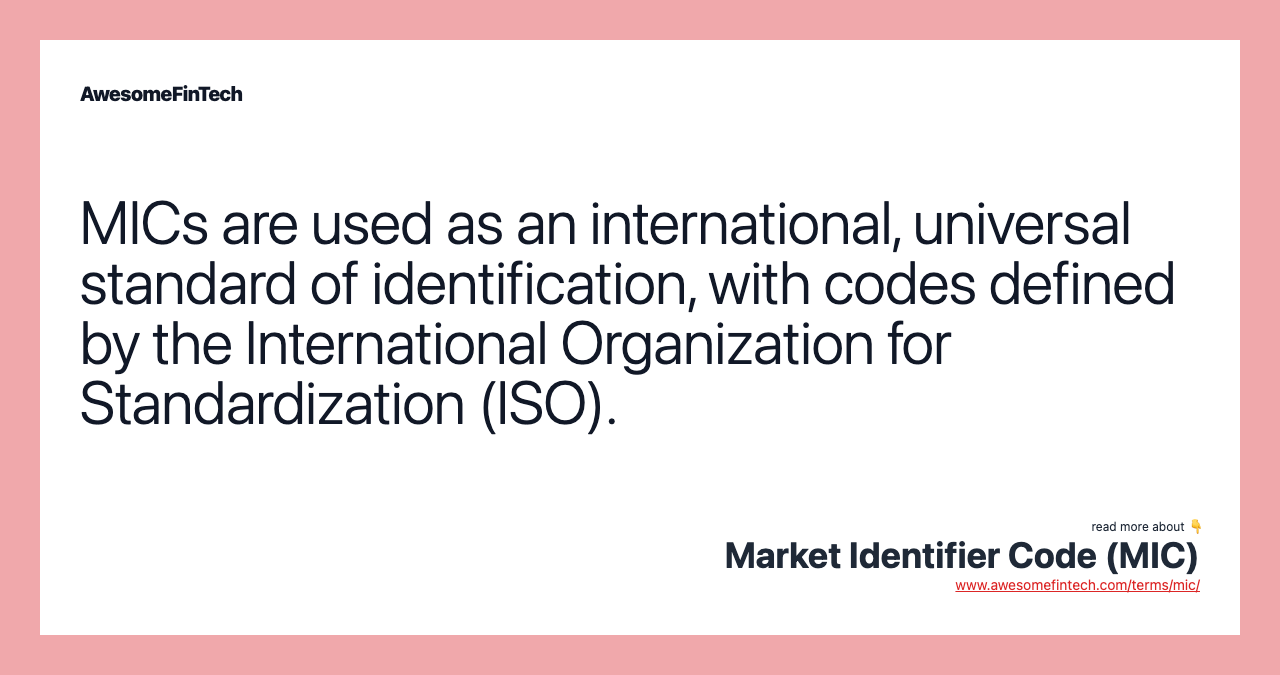Market Identifier Code (MIC)
A market identifier code (MIC) is a four-character code used to identify stock markets and other trading exchanges within global trading and referencing computer systems. A market identifier code (MIC) is a four-character code used to identify stock markets and other trading exchanges within global trading and referencing computer systems. For each market segment MIC, there is a parent MIC, also known as an operating MIC. The code is unique, includes four characters, starting with a randomly-assigned alphanumeric character, followed by a three-digit code to signify the market, such as XNAS for the Nasdaq market. An operating MIC, in turn, identifies the entity that operates an exchange, trading platform, regulated or non-regulated market, or a trade reporting facility in a specific country.

What Is a Market Identifier Code (MIC)?
A market identifier code (MIC) is a four-character code used to identify stock markets and other trading exchanges within global trading and referencing computer systems. The first letter of any MIC is randomly allocated followed by a three-digit alphanumeric code for the market in which a trade takes place. Submitters can propose a combination of four characters, but the Registration Authority remains ultimately responsible for the assignment. Once allocated, a MIC code cannot be modified.
The MIC code is used to process and clear trades and is being pushed toward global acceptance as the securities industries move toward straight-through-processing (STP). The London Stock Exchange uses MICs as part of its SEDOL security-identifying systems, which is an alternative to the U.S.-based CUSIP identifying system.



Understanding Market Identifier Code (MIC)
Straight through processing, a conceptual approach for improving the speed of processing transactions is considered to be the holy grail of global securities trading. In order for it to be possible, there will need to be a wealth of consistent codes for the market of origin, currency, and security identification. As it stands now, there are several different systems used by different countries and for differing types of securities.
One global standard will have to emerge over time, and all of the software and processing systems will have to back it, making the necessary technical changes along the way. This process will take time as securities industries move toward the ultimate goal of an "any security, anywhere, anytime" marketplace.
The International Organization for Standardization (ISO) publishes the MIC list of all countries on the second Monday of the month.
How Market Identifier Codes Are Used
MICs have been presented by ISO as an international standard to identify markets, trading platforms, and exchanges to allow for automated processing of trades. With MICs being used as the universal identifying standard, it could be a significant step in bringing straight-through processing closer to being realized beyond the concept phase.
There are different types of MICs. A market segment MIC identifies a section of one of the entities covered by the code that specializes in one or more specific instruments or is regulated differently. Market segment MICs were instituted for more accuracy, according to ISO.
For each market segment MIC, there is a parent MIC, also known as an operating MIC.
An operating MIC, in turn, identifies the entity that operates an exchange, trading platform, regulated or non-regulated market, or a trade reporting facility in a specific country.
Market organizations can apply for a MIC by submitting a request to the registration authority. Typically, a market segment MIC is generated when demand merits the need to identify the segment. Depending on the circumstances, it can happen that only specific segments of a market receive identification with a market segment MIC.
Related terms:
CINS Number
A CINS number is a unique identifier for securities offered outside of the United States and Canada. read more
CUSIP Number
The CUSIP number is an identification number assigned to all stocks and registered bonds by The Committee on Uniform Securities Identification Procedures. read more
Dummy CUSIP Number
A dummy CUSIP number is a temporary placeholder used internally by a company to identify a security until its official CUSIP number is assigned. read more
International Securities Identification Number (ISIN)
The International Securities Identification Number (ISIN) is a 12-digit alphanumeric code that uniquely identifies a specific security. read more
International Securities Association for Institutional Trade Communication (ISITC)
The International Securities Association for Institutional Trade Communication (ISITC) is an organization promoting greater financial market efficiency. read more
ISO Currency Code
ISO currency codes are three-letter alphabetic codes that represent the various currencies used globally. read more
London Stock Exchange (LSE)
The London Stock Exchange (LSE) is the main stock exchange in the United Kingdom. The LSE provides access to electronic trading for thousands of stocks. read more
Stock Exchange Daily Official List (SEDOL)
The stock exchange daily official list is a seven-character ID code assigned to securities listed on the London Stock Exchange and other UK exchanges. read more
Stock Market
The stock market consists of exchanges or OTC markets in which shares and other financial securities of publicly held companies are issued and traded. read more
Straight-Through Processing (STP)
Straight-through processing is an automated electronic payment process that is used by corporations and banks. read more